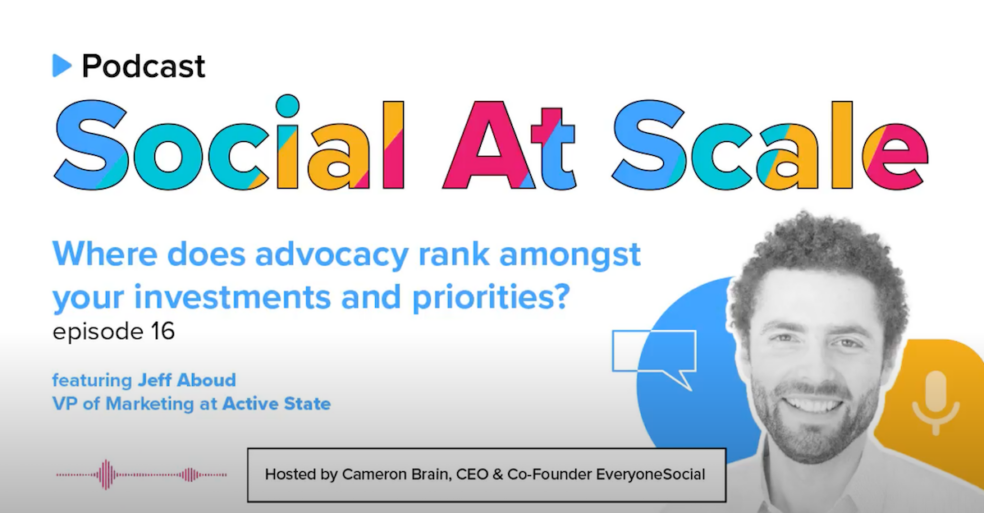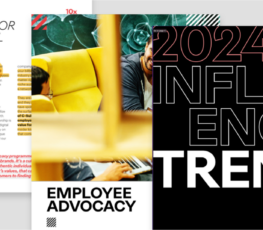Marketing specifically, now lives or dies at the speed of dog years.
The speed that marketers need to pay attention to now isn’t how fast your tactics run, but in terms of how fast your brand can adapt to tool degradation and therefore new challenges.
With so much accelerating, we all have to innovate and explore new ways to get to market and communicate our value.
Nowadays after returning from even just a month-long sabbatical can make one feel like they are emerging from a bunker in a bygone world of “best practices”.
Even with so much changing any given week, there have been obvious trends over the past decade. The tried and true brand disciplines of content marketing, inbound organic, email, paid ads are all getting more expensive and results are declining.
What isn’t degrading? Employee networks, and everyone has one.
In today’s episode of Social At Scale, VP of Marketing at ActiveState Jeff Aboud sits down with Cameron to discuss how to diversify and maintain an adaptive advantage in marketing.
But just because trends change overnight and time is flying (in dog years) doesn’t mean marketers are now man’s best friend. That said, more than ever before, leaders will need to resist the urge to run with the pack, and learn from the lessons discussed in this episode.
In this episode Jeff and Cameron explore:
- How to get the word out of who you are as a company
- ICP to ICP, the Holy Grail of exposure and how to get it
- Why just posting content internally never goes anywhere
- Going beyond performance with demand creation
- The only way to get immediate inbound success
Watch the Full Episode
Three rules for winning in a changing world:
Key takeaway 1: employees are invaluable
Who is your ideal customer profile (ICP), and who within your organization is best enabled to engage with them?
Chances are, you have a whole team of employees who have the same interests, industry sources, and objectives as your ICP out there in the wild.
As in Jeff’s case, developers are paramount, so enabling their engineers with employee advocacy was the most cost effective and efficient way to reach their audience.
Because the advocacy cadence at ActiveState is “by devs for devs”, their UGC is personal and authentic. Each post has a face associated with it, and therefore is perfect for beginning conversations with customers, candidates, and prospects.
Key takeaway 2: empower, don’t dictate
Following from the first takeaway, take care not to abuse the invaluable trust of your people.
The combined value of your employees’ networks constitutes your company’s net brand.
Let that sink in for a second – and so, it’s imperative to activate employees to share as themselves, not as your company. In other words and in a social first marketing world, your employees are your company, not your brand. This may seem obvious, but it’s easy to overlook.
If employees (especially your ICP-sympathetic employees) feel as if they are being instrumentalized, they will check out and you’ll be without authentic advocates.
As Jeff points out and corroborated by his CTO as well: when employee content sharing initiatives are forced, they always fail.
Instead of rolling out an employee advocacy program as obligatory and prescriptive, open up moderator roles to your people and let them lead from the beginning. This sense of ownership will organically structure your UGC program for optimal returns on your investment; pennies on the dollar compared to paid ads.
Taking a top-down approach however will discourage especially the highly talented employees from leveraging their social trust online. But those are exactly the employees you want sharing, in their own way.
In the end, your employees are the experts, and in their social outreach will brands entrust their futures henceforth.
Key takeaway 3: social media managers love it
Does your SMM spend way too much time manually scheduling content and corralling employees to consider engaging on their networks and company posts?
We get it, and many might shrug saying “Well, that’s their job, right?” However this is a reactive way to manage social, and keeps any SMM from their real impact: strategically and proactively cutting through the noise.
If there’s any hesitation as to whether rolling out an advocacy program might step on the toes of your social media manager, fret not. The exact opposite is the case.
While you should empower your employees (again, especially your people who are most sympathetic to your ICP), giving your SMM the keys to the program will supercharge their impact.
While many SMMs have their preferred kanban-style task platform, list-making apps aren’t enough anymore for UGC management as they were never built for it in the first place.
Employee advocacy platforms are a necessary component to any social media manager’s toolkit, and as discussed in today’s episode: you’ll get multiples more out of your SMM.
If you’ve found yourself in the dog pound of marketing and looking to break ahead with social demand creation and employee inbound lead generation, shoot us a note and we’re happy to talk more about how EveryoneSocial will get you there in no time.















